Types of TensesTense is the type that a verb takes to reflect the moment of action. Tenses are very important in the English language, and it signifies the time at which an activity occurs, be it in the past, in the present, or at some point in the future. 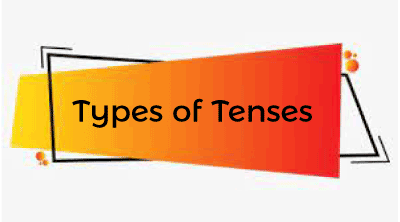
Tenses and their variationsFrom a broad perspective, this lesson will continue to examine each tense in detail with instances and a new technique to learn tenses using instances and exercises. Tenses and TimeTime is primarily segmented into three portions: the past, the present, and the future. A tense is a verb form that communicates time. For instance, "she goes" is the present tense of the verb "to go," but "she went" is the past tense of the same. As a result, the verb alters its type to indicate if an action occurs in the present or in the past. 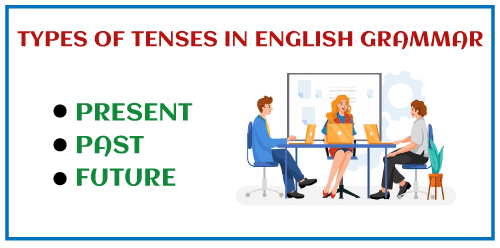
TensesIn English, there are 2 tenses: simple present and simple past. Note: Always remember that there's no future tense to describe the future period in the English Language.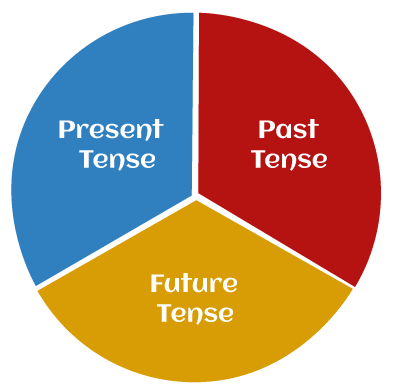
To describe future time, we employ the modal auxiliaries like shall and will in the present simple tense, and so on. Tenses on the basis of AspectIn English, there are two types of aspects: progressive (continuous) and perfect. The progressive iterates that an activity is still in process, but the perfect aspect indicates that the job is finished. As we can see, the simple present tense is constructed by employing the simple infinitive. However, for the third person single (He, She) and singular nouns, -s or -es are appended to the bare infinitive (i.e., infinitive without 'to') (Nitu). Negative sentences are formed by putting doesn't or don't before the primary verb. Do or does are used before the subject to produce interrogative phrases. Negative interrogative sentence are constructed by placing do or does just before the subject and not behind or after it. The brief forms, on the other hand, do not and do not appear before the topic. There are twelve types of tenses on the basis of verbs. 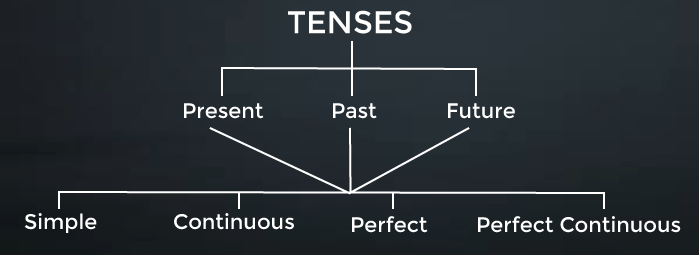
Now let us have a detailed overview of all the tenses in English Grammar with examples. 1. Present TenseThe present tense (acronym pres or prs) is a grammar tense used to locate a situation or occurrence in the present. The present tense can be utilised to illustrate the actions that are taking place right now. To describe and comprehend the present tense, envision time as a path on which the past, present, and future tense are placed. The phrase present tense is often employed in language descriptions to describe a particular grammatical form or group of forms; these may have a range of applications, not all of which will apply equally to the present moment. In the Sentence "My train leaves tomorrow morning," for instance, the verb form leaves is in the present form, even though the meaning or the reference of the activity is in the future or coming time. Similarly, in simple explanation, The present tense relates to a verb that relates to the current moment; for example, I read this letter to support you. Likewise, in the historic present, the present tense is employed to describe previous occurrences. Like most Indo-European language, there seem to be two sorts of present tense forms: the present indicative (a mix of present tense and indicative mood) and the present subjunctive (the combo of present tense and subjunctive mood). The said tense is segmented into 4 sections:
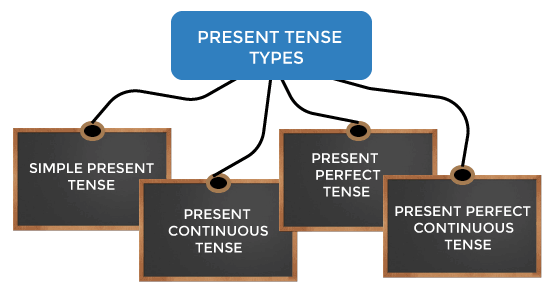
UsageBesides the third-person singular form, which has the suffix -[e]s, the present indicative among most verbs in contemporary English includes the very same form as the infinitive. The verb be has three different forms: am, is, and are. There are a multitude of numerous word structures that are present to convey the combos of present tense with the simplest type of the present tense is renowned as the simple present; also, Also it comprises of structures recognized as the present continuous or progressive (or present continuous) (e.g., am submitting), the present perfect (e.g., have printed), and the present perfect continuous or progressive (e.g., have been singing). The usage of the present tense doesn't really necessarily imply that the time is now. The present tense, for instance, is frequently employed to speak to future events ( I am meeting James tonight; my train departs at 3 p.m. this evening). This is especially true in conditional clauses and other adverbial subordinate clauses: If you meet him,...; When they come... There is also the historic present, which uses the present tense to describe previous occurrences. Now read on to have a glance at the subsections of Present Tense Simple Present TenseIt's utilized to represent everyday chores, facts, and universal truths. The present tense is often used to represent what is occurring at the moment, what occurs on a daily basis, or what is a reality in and of itself. A simple present tense is made by fixing the characters s or es. Like - Likes Love= Loves You, We, They: Like/love to eat outside. He, She, It: likes/loves to eat outside. for example- Rashu writes a letter. Stars comes out at dusk. Mumbai is the financial capital of India. Present Continuous TenseIt is used to convey an activity or event taking place when the sentence is being spoken. Some examples of this tense are reading, watching I: I am studying the notes right now. You, We, They: are watching their favorite episode right now. He, She, It: is reading their favorite book at the moment. Present Perfect TenseIndicates an activity that occurred somewhere before the present instant and had an effect on the current situation. The present perfect tense is utilized to depict the finished actions or events. Note The Present Perfect Tense seems to have the type has/have + verb (past participle forms or 3rd form or type of the verb)Some of the examples of this tense are, "He has finished the work." "He has slept." I, You, We, They: have finished the work. He, She, It: has ruined time. Some more examples include; I have read the book you admire the most. He has been to Canada. Present Perfect Continuous TenseWhen the emphasis is on an activity that is not yet accomplished or finished, we employ the present perfect continuous. It represents an action that started in the past and is still ongoing in the present. Some of the instances of this type of tense are I, You, We, They: have been studying for a month. He, She, It: has been studying for a month. for example- I have been standing for the bus for an hour. It has not been snowing since last Monday. He has been dancing for an hour. 2. Past TenseThe past tense is a grammatical tense that is used to refer to an act or activity that happened in the past. Some of the English verbs like sang, went, and danced are instances of past tense verbs. Most languages include a past tense, but some have numerous forms to show how far back the activity occurred. Some languages have both a compound past tense that uses auxiliary verbs and an imperfect tense that describes continuous or recurring occurrences or activities. Certain languages alter the verb, changing the end to signify the past tense, but non-infected languages may employ other terms to express that something happened in the past, such as "yesterday" or "last week." UsageThe past tense (or preterite) is among the verb's inflected types or forms in English. Normal verbs' past tenses are created by adding -t, -d, or -ed to the main form of the verb, but irregular verbs' past tenses are created in a range of methods (such as seesaw, go went, be was/were). The past tense version of regular and some irregular verbs also functions as a past participle. The past perfect construct is frequently used to allude to past events, as in I have accomplished (also known as present in the past). However, this is not considered a past tense instance; rather, it is considered a mixture of present tense with perfect aspect, expressing an existing scenario that derives from past activity. There are several multi-word forms for merging past tense with progressive or the continuous aspect, which signifies ongoing action; perfect aspect; and progressive and perfect aspects combined. Some of the instances of this tense are, Simple Past TenseIt is utilized to showcase an action that happened in the past. A temporal adverb frequently follows it. It can also be utilised without the requirement for a time adverb. Applied to previous habits. The simple past is made up of only the past tense (preterite) verb forms (he marched, they sailed, etc.), but when it is negated, stressed, or inverted, it is often required to unfuse the verb, employing a periphrastic construct with did (as in did he move? etc.) -. The simple past is used to describe single events or habitual events in the past, and it is also used to describe states that existed previously. Some of the instances of this type of Tense are He danced at the function. He flew to Canada a day before yesterday. I went to college. You excelled in exams. She did not visit the musuem (The event or the task that happened in the past is completed and is totally not relating to the present time.) 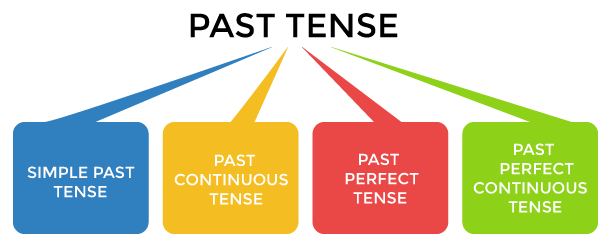
Past Continuous TenseThe past progressive, also known as the past continuous tense, is constructed by combining the simple past of be (was or were) with the present participle of the main verb: He was traveling. This type indicates that activity was in progress at the moment in question. In English, the past continuous tense is indeed very essential, and we utilize it to explain what we were doing at a given point in the past. Some of the examples I, she, he, it- was singing in the playground. They, We - were singing in the concert. Or some more examples of the same are I was baking last night for my brother's children. They were not studying when I looked on them. It was getting colder. The electricity went out while they were studying. Past Perfect TenseThis type of tense defines a past action that was done before another time or occurrence in the past. The past perfect tense is simple to grasp and apply in a phrase, and this tense refers to an event that occurred in the past. If two activities occurred in the past, the past perfect tense is employed to show the previous activity. The past perfect combines had (the simple past of had) with the main verb's past participle: We had yelled. This indicates that activity occurred prior to a given time in the past and hence functions similarly to the pluperfect involved in different languages. Some of the instances of this type of tense are; I, he, she, it, we, they - had reached the railway station They were too late the show had already started. I thought I had seen the show earlier, but I was incorrect. "She had played before it began to snow." "He had studied before I came back from the office." Past Perfect ContinuousUsed to describe a situation that began before a specific point and extended until a given point in the past. The past perfect progressive blends had (the simple past of have) with been (the past participle of be) and the primary verb's present participle: You had been listening. This type of tense clearly specifies a past action that occurred prior to some other time or occurrence in the past and was continuing throughout the second event/time point in the past. Some of the instances of this type of tense are; I, he, she, we, it, you, they - had been studying on the table when I reached home. Shalu was very happy. She had been singing. Had the pupil been wandering outside the classroom? At that time, she had been studying a book for two months. He had been dancing when I arrived. 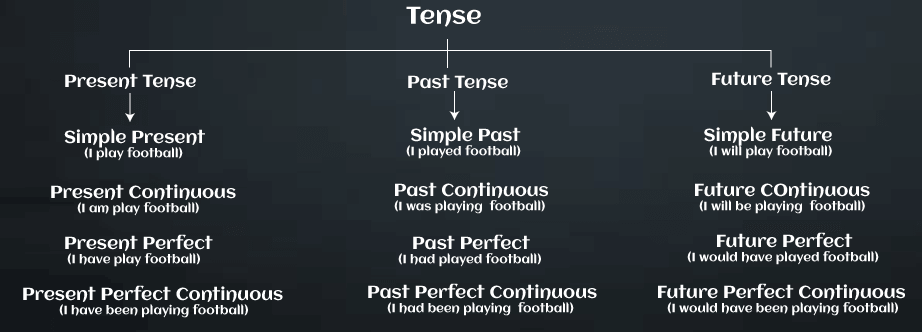
Future TenseIn English, a future tense (abbreviated fut) is a verb type that normally indicates that the event represented by the verb has not yet occurred but is anticipated to occur in the future. A future tense type is the French aimera, which means "will love" and is taken from the verb aimer ("love"). The "future" indicated by the future tense normally refers to the future in relation to the time of speaking. In contrast, in settings where relative tense is utilized, it may refer to the future in relation to another moment in time under review. Although English lacks an inflectional future tense, it does contain a number of syntactic and lexical techniques for communicating future-related ideas. UsageModal auxiliaries such as will and shall, as well as the futurate present tense, are examples. There are several techniques in English grammar to convey the future aspect of an occurrence. Some say that English lacks a future tense-that is, a grammatical type that always expresses the future-as well as a required form for expressing the future. Furthermore, there are various commonly accepted ways to convey future-ness in English. Some of them-especially those involving will or shall-are typically referred to as future tense. The type of the will/shall future is commonly referred to as the simple future (or future simple). Other formulations include future continuous or progressive (or future continuous) as in "She will be studying," future perfect as in "He will have completed," and future perfect continuous or progressive as in "They will have been preparing. Some of the examples of this tense are, 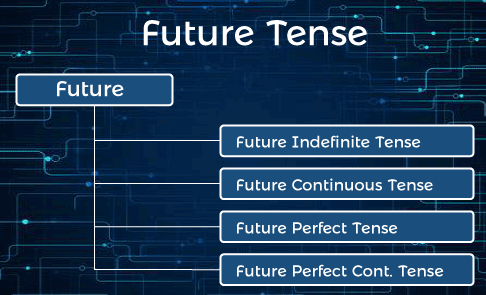
Simple Future TenseSpecifies an act that will occur after the present moment and has no real relationship to the present time. The time that passes after starting a sentence is referred to as the future tense, and this tense expresses future events and occurring. Some of the examples are I, He, she, it, we, you, they - will/shall play the harmonium day after tomorrow. Radha will formulate the queries this week. He will never admit about this. He will visit her ailing sister soon. She will walk to the university. Future Continuous TenseIt's being used to represent an action that will take place or continue in the future. e.g., He will hand out promotion letters at the workplace tomorrow at 12 p.m. In this instance, the activity will begin in the future (tomorrow) and will be continued until some point in the future. It represents a future course of action that is substantially longer than the other future action. Some of the examples of this type of tense are; I, he, she, you, it, they, we- will be arriving at the airport tomorrow. I will be playing the guitar at the party tomorrow. She will be singing a song. He will be driving when it starts to drizzle. Future Perfect TenseThis type of tense showcases a future action that will be completed prior to another time or occurrence in the future. It is utilized to represent an event that will happen in the future and will be accomplished by a specific period in the future. Often this is utilized when the future perfect is employed to indicate that something would be completed by a specific date in the future. Some of the examples of this type of tense are; I, he, we, she, they, it - will have lunch at 2 pm He will have forgotten her by then. He will not have written an email. By the time we leave, he will have slept. Future Perfect Continuous TenseIt is used to describe events that will begin at a specific time in the future and will continuously happen for an indefinite time. The future ideal maintains constant attention on the length of an action that will be in process prior to another time or occurrence in the future. It represents a future activity that will continue until another time or occurrence in the future. It is also used to refer to acts that are planned or actions that are predicted to occur. Some of the instances of this type of tense are Tomorrow at 2 pm, I will be in the plane to Delhi. Cousins will be residing at Aunt Rina's home. She will have been rehearsing an hour at 7:00
Next TopicPresent Continuous Tense Exercise
|
 For Videos Join Our Youtube Channel: Join Now
For Videos Join Our Youtube Channel: Join Now
Feedback
- Send your Feedback to [email protected]
Help Others, Please Share










